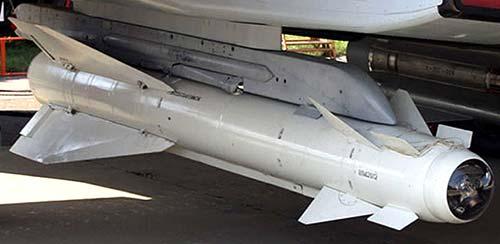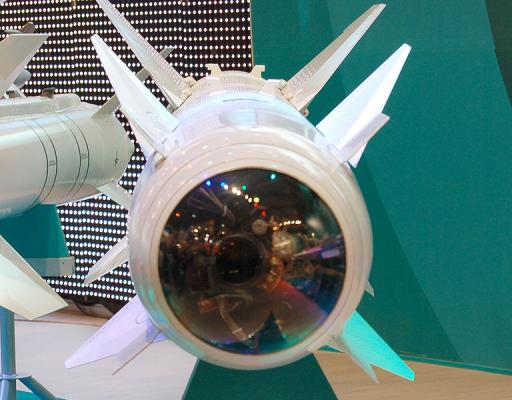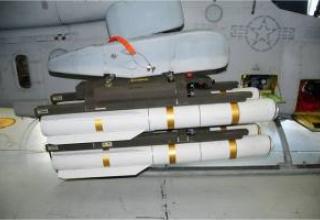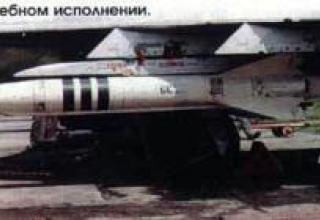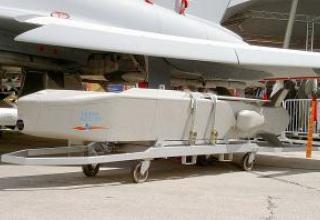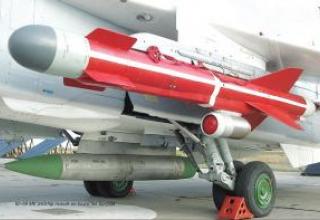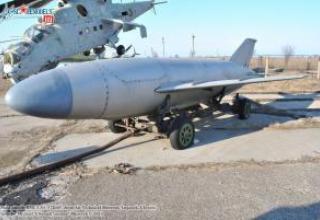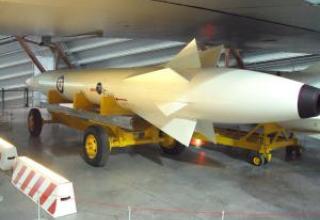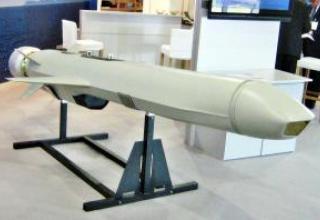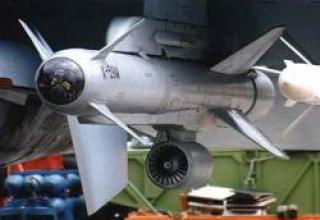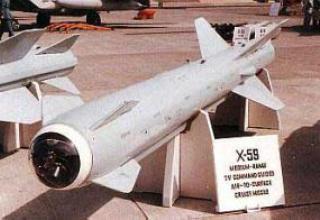X-29T missile is designed to engage visually visible ground and surface targets such as: reinforced concrete shelters, stationary railway and highway bridges, industrial facilities, warehouses, concreted runways, ships and landing vehicles with displacement from 5000 to 10,000 tons.
The development of the X-29T missile with a TV homing head began at the Lightning Design Bureau under the supervision of Chief Designer M.R.Bisnovat, and later the work was transferred to the Vympel Design Bureau. The carrier aircraft are the Su-17M4, Su-24M, Su-25, Su-34, Su-35, MiG-29SM, Su-25T, Su-27M, MiG-27K (M,D) and MiG-29M.
The X-29 family of missiles has a modular design and differs in the type of the installed PSN. The engine, combat unit, fuse and electro-pneumatic system of X-29T rocket are the same as on X-29L rocket.
In addition to the two basic options, ICB "Vimpel" reported on the development of missiles X-29TE (X-29TE) with an increased range of 20 - 30 km and X-29ML in combination with a long range illumination and range measurement station and models with an autonomous coherent radar development of Phasotron-NIIR.
In the west, the missile was designated AS-14 "Kedge".
Composition:
X-29T rocket has an aerodynamic "duck" scheme (see projections, layout scheme). The X-29T body consists of five compartments - CNS, control compartment, BC, engine and tail compartment, which can be stored in the capping separately and are assembled during the preparation using the flange joints.
In order to improve controllability, destabilizers are installed in front of the steering wheels, called on the X-29 "bearing ridges". Rack control (stabilization) is carried out by ailerons on the wing. Power supply to the systems and PSN is provided by an ampoule battery and an electromechanical alternating current converter with a power supply resource of 40 seconds.
To defeat strong and protected targets, the missile is equipped with a powerful penetrating BC 9B63MN weighing 317 kg, and equipped with a contact fuse KVU-63, which provides a given slowdown after breaking through the barrier, destroying the contents of the shelter. The BC is equipped with a special anti-aircraft device on the front end, which increases the effectiveness of the impact at small "sliding" angles of encounter with the target, frequent when launching from low altitudes and distances. The operating mode of the fuse ("instantly" or "with deceleration") is set by the pilot, and contact sensors are placed in front of the BC in the steering wheel area and run along the front edges of the wing. The rugged casing accounts for the bulk of the BC mass, with an explosive weight of 116 kg.
The X-29T rocket has a passive television homing system (see photo). Measurement of angles of target bearing and angular speed of the sighting line is made with the help of the TV SAT "Tubus-2", the field of view angle of which in the target search mode is 12° x16° and in the auto tracking mode - 2.1° x2.9° . The maximum angular speed of the line of sight is 10° /c.
TGSN "Tubus-2" consists of opto-electronic part with a target coordinator, mounted on a cardan suspension, and an electronic information processing unit that provides selection and memory of contrasting objects. Target search can be carried out using the aircraft's onboard equipment or visually by a pilot.
Having found the target and "drove" it on the sighting and piloting indicator, the pilot performs binding and target designation TGSN, after which the image of the target appears on the screen of the TV indicator in the cockpit. The supposed object of attack can be "snatched" by the camera from the general background, and its image is enlarged for identification. After selecting a target, a transition from a wide field of view of the TGSN to a narrow one is made, and to save the capture the pilot only has to hold the sighting frame on the target, waiting for proximity to the permitted range of launch.
The vertical control system operates in two modes, autonomous and homing. Stand-alone control is carried out on the initial flight section of the missile, homing - on the last one. After separation from the aircraft carrier autonomous control provides flight of the missile with a constant pitch angle. At achievement of equality of a current angle of bearing and the set control system makes program turn of a rocket on a target till the moment of equality to zero of a current value of angular speed of a sighting line. After that, the missile control system switches to passive television homing using the proportional approach method. Television homing is passive and is performed along the light-contrast edge of the target. The visibility of the target can be accentuated not only by its contrasting colour, but also by the angle of incidence of the sun's rays or shadows giving off a disguised object. The missile makes a "slide" in front of the target.
X-29T can be launched from low altitudes. The range of its application is mainly determined by the possibility of target detection and strongly depends on the flight altitude, atmospheric conditions, contrast, size and configuration of the target. The circular probable deviation at launch from the optimum target detection conditions of 4-5 km is 2.2 m.
When the missile strikes runway airfields, it leaves craters with a diameter of 12 to 15m and depth of 6m.
For transportation and storage of X-29T missile a container is used.
Characteristics:
| Developer | Vimpel ICB |
| Manufacturer | Leningrad North Plant, BAPO "Iglim" |
| Rocket | |
| Range of fire, km | 3-12 |
| Flying speed of the carrier, km/h. | 600-1250 |
| Launch altitude, km | 0.2-10 |
| Maximum flight speed, m/s | 450 |
| Average flight speed, m/s | 250-350 |
| Dimensions: | 1 |
| - length, mm | 3875 |
| - maximum housing diameter, mm | 380-400 |
| - wingspan, mm | 1100 |
| - steering wheel range, mm | 750 |
| Start weight, kg | 680 |
| Homing Head | |
| - type | passive television station Tubus 2 |
| - developer | The NGO "Impulse" (MNIITI) |
| - spectral range,μm | 0.4-0.95 |
| - luminosity, lightness | 50-10000 |
| - field of vision, deg | 2-3 |
| - TV standard | 625 lines, 50 Hz |
| - resolution, lines | 550 |
| Fighting unit | |
| - type | unbelievably penetrating |
| - weight, kg | 317-320 |
| - explosive weight, kg | 116 |
| Transport container | |
| -length, mm | 4350 |
| - width, mm | 900 |
| - height, mm | 860 |
| - package weight , kg | 1030 |
| X-29TE rocket | |
| Location | on AKU-58TE launchers |
| Start weight, kg | 690 |
| Length, mm | 3900 |
| Wingspan, mm | 1100 |
| Starting range: | |
| maximum, km | up to 20...30 |
| minimum, km | 3 |
| Launch altitude, km | 0,2...10 |
| Weight of combat unit, kg | 320 |
| Type of combat unit | blistering, penetrating type |
Testing:
In April 1987, in Afghanistan, the Su-25 A.Rutsky and Komeks Vysotsky, attacking carved out in the rocks near Khost warehouses, for the first time used guided missiles X-29L and X-25 with laser homing, illumination of the target for which the on-board rangefinder designator "Klen-PS" could lead and another attack aircraft, but such a technique was used infrequently for the same reason - pilots are not always able to distinguish and fix the beam low visibility objects. Thus, at the first use of the four launched X-29L in the targets, tightened with smoke, hit only two. The best results were given by the help of a ground gunner who knows the terrain well. At first, the ground laser designators tried to be mounted on APCs and BMPs improvised, then they were replaced by standard aircraft guidance combat vehicles (BOMAN) based on BTR-70, on which the system was hidden under armor and moved out while working.
The enemy quickly evaluated the importance of the unusual-looking vehicles and tried to shoot them first. After several particularly successful launches, when the missiles covered the headquarters and Islamic committees, the hunt for BOMAN began on roads and parking lots, forcing the vehicles to hide behind barbed wire and mine fences of well-guarded airfields. The rockets became a reliable weapon to destroy cave shelters, almost invulnerable to other munitions. The Mujahideen used them for storages and caches, and equipped weapons repair workshops (there was an entire cartridge factory in the cave town at the Jawara base). The mountains covered with burrows were turned into natural fortresses - dragging recoilless DShK guns and mortars upwards, dushmans arranged firing positions closed from below and artillery and tanks could not knock them out. The fire from the high rocks was extremely precise, and steep slopes and rubble did not allow to reach them. When using aircraft, the enemy was hiding in the depths under thick vaults, and bombs and ANR wastedly crushed the rocks around. After waiting for the raid, the shooters went outside and continued to fire. The accuracy of hitting the X-29L and X-25 was striking - the missiles could be placed exactly in the entrances of caves and embrasures, and their solid BC with an excess was enough to destroy the target. Heavy X-29L with BC weighing 317 kg, encased in a solid body was especially effective. Breaking through the stone, it went deep and cracked the most impregnable objects from inside. If the cave was hiding ammunition depot, the success was truly stunning.
The Su-25 rocket attack was vividly described by the commander of an airborne company pressed to the ground by fire from a dot hovering over Baglansky Gorge: "I could not lift my head when suddenly a couple of planes jumped over us, and immediately something light flew into the embrasure between the rocks and blew the dot into the crushed stone". More often than not, rather expensive rockets were used against single targets, using intelligence and carefully preparing each blow. Launches were carried out from a range of 4-5 km from a gentle dive at an angle of 25-30 degrees, the deviation of the missiles from the point of aim at this did not exceed 1.5-2 m. According to Sukhoi Design Bureau, in total, the DRA conducted 139 guided missile launches.
The calculations of combat effectiveness of the X-29L look quite convincing: Thus, a link of fighter-bombers with a full load of FAB-500 and S-25 (8t bombs and 4 missiles) was required to destroy a large target, while the same task could be solved by one Su-25 attack aircraft with a pair of X-29s; the 100m-long bridge was disabled by six aircraft with a dozen FAB-500s or just a pair of four X-29s.
Sources:
- А.В.Карпенко, С.М. Ганин "Отечественные авиационные тактические ракеты", "Бастион" N1, 2000г.
- В.Марковский, К.Перов "Советские авиационные ракеты "воздух-земля", "М-Хобби" N1(41), 2003г, стр.26.
- AIR-TO-SURFACE MISSILE OF INCREASED RANGE Х-29ТЕ. Рекламный листок JOINT STOCK COMPANY "STATE MACHINE BUILDING DESIGN BUREAU "VYMPEL BY NAME I.I. TOROPOV". Первая половина второго десятилетия ХХI века (материал предоставлен Гуровым С.В. (Россия, Город-Герой Тула).
